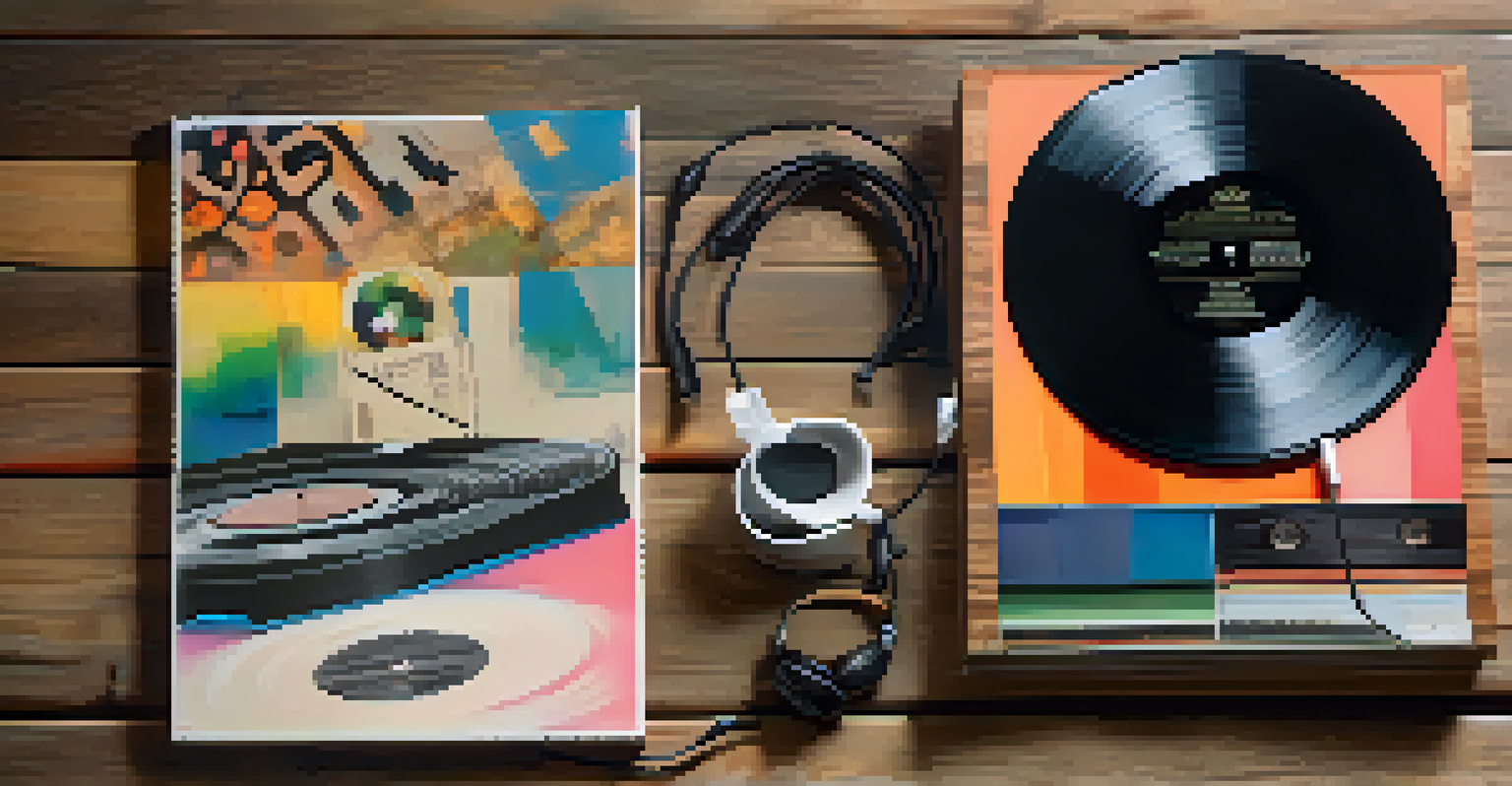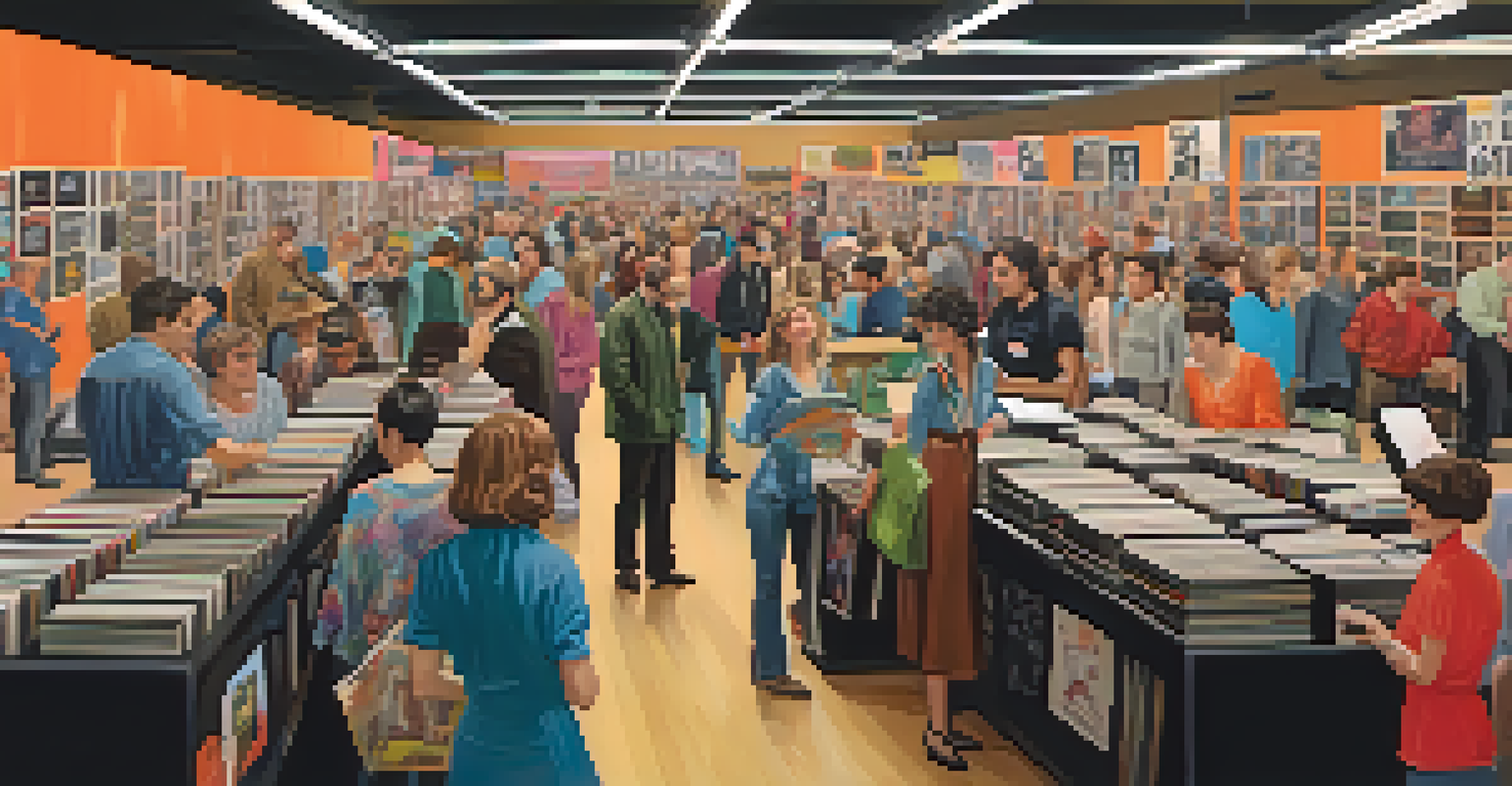Vinyl Records: Resurgence of Analog in a Digital Age

Understanding the Vinyl Resurgence in Today's Music Scene
In recent years, vinyl records have made a striking comeback, captivating both old-school audiophiles and a new generation of listeners. This resurgence is not just a fad; it reflects a growing desire for tangible, high-quality music experiences amidst the digital noise. Many people are seeking a connection to music that goes beyond mere streaming, opting for the warmth and authenticity that vinyl offers.
Vinyl records are a tangible connection to the music and the artists we love.
Interestingly, sales figures tell a compelling story. According to the Recording Industry Association of America (RIAA), vinyl sales have been steadily increasing, surpassing CD sales in recent years for the first time since the 1980s. This trend showcases a cultural shift where people are willing to invest in physical music formats that provide a richer listening experience.
The revival of vinyl is also seen as a response to the fast-paced digital world. As more listeners embrace the nostalgia of flipping through record collections, they enjoy not only the music but the entire ritual of playing a record. This tactile engagement fosters a deeper appreciation for the artistry behind albums, making vinyl an attractive option for many.
The Unique Sound Experience of Vinyl Records
One of the key reasons vinyl records are cherished is their distinct sound quality. Many enthusiasts argue that analog recordings capture nuances and warmth that digital formats can sometimes miss. For instance, the crackling of a record can evoke a sense of nostalgia, transporting listeners to a different time and place.

Vinyl records have a dynamic range that can provide a fuller sound, with deeper bass and clearer highs. This is particularly appealing to those who appreciate genres like jazz, rock, or classical music, where rich tonal qualities shine through. The physical grooves on a vinyl record translate sound in a way that resonates deeply with many listeners.
Moreover, the act of playing a vinyl record encourages mindfulness. Unlike the instant gratification of digital playlists, vinyl requires attention and intention. Listeners often engage with the music on a more profound level, savoring each track and enjoying the journey rather than just the destination.
Collecting Vinyl: A Passion Project for Many
For many, collecting vinyl records is more than just a hobby; it's a passion project. The thrill of hunting for rare albums at thrift stores, flea markets, or online auctions adds an exciting element to the experience. Collectors often find joy in discovering hidden gems, whether it’s an obscure band from the ‘70s or a limited edition press.
The beauty of vinyl lies in its imperfections, giving each record a unique voice.
This sense of community among collectors further fuels the vinyl resurgence. Events like record fairs and swap meets allow enthusiasts to connect, share stories, and trade albums, creating a vibrant culture around vinyl. Social media platforms have also played a significant role in bringing collectors together, providing spaces to showcase collections and discuss music.
Additionally, many collectors appreciate the artwork and packaging of vinyl records. The larger format allows for more intricate designs, often turning album covers into pieces of art in their own right. This visual aspect adds another layer of enjoyment for collectors, making each record a treasure to admire.
The Role of Independent Labels in Vinyl Production
Independent music labels have significantly contributed to the vinyl resurgence by prioritizing quality over quantity. Many indie artists are turning to vinyl to release their music, embracing the format as a way to stand out in a crowded digital landscape. This shift allows them to connect more authentically with their audience, who often appreciate the effort and craftsmanship behind physical releases.
These independent labels are also reviving classic albums and introducing new artists through vinyl releases. By focusing on limited runs and special editions, they create a sense of exclusivity that resonates with collectors and casual listeners alike. This strategy not only promotes the artists but also helps sustain the vinyl industry.
Moreover, the collaboration between artists and independent labels fosters innovation in sound and presentation. As musicians explore new genres and styles, they often choose vinyl to showcase their creativity, leading to a diverse array of records that appeal to various tastes. This dynamic relationship is pivotal in keeping the vinyl scene fresh and exciting.
Vinyl Records vs. Digital Music: The Ongoing Debate
The debate between vinyl and digital music continues to spark passionate discussions among music lovers. Advocates of vinyl argue that the analog format offers an immersive experience that digital simply cannot replicate. The physicality of handling records and the patience required to listen to them fosters a deeper connection to the music.
On the other hand, digital music provides unparalleled convenience and accessibility. With just a few clicks, listeners can access vast libraries of songs and playlists. However, this convenience sometimes leads to a more superficial engagement with music, where songs are played in the background rather than truly listened to.
Ultimately, both formats have their merits, and many music enthusiasts embrace a hybrid approach. While they may enjoy the convenience of streaming for everyday listening, they often reserve vinyl for special moments when they want to dive deep into the music. This balance allows listeners to appreciate the strengths of both mediums.
The Influence of Nostalgia on Vinyl's Popularity
Nostalgia plays a significant role in the resurgence of vinyl records, particularly among millennials and Gen Z listeners. Many individuals are drawn to vinyl as a way to connect with the music of previous generations, often discovering the artists their parents or grandparents loved. This emotional connection adds a layer of depth to their music experience.
Moreover, the unique rituals associated with vinyl—like browsing through record stores or hosting listening parties—create lasting memories. These experiences resonate with younger listeners who crave authenticity in a world dominated by digital interactions. Vinyl records provide a tangible connection to the past, enriching their appreciation of music.
As a result, vinyl records have become more than just a medium for music; they symbolize a cultural movement that values tradition and craftsmanship. This nostalgia-driven interest is encouraging a new generation to explore not only the sound of vinyl but also the history and stories behind the albums they cherish.
Looking Ahead: The Future of Vinyl Records
As we look to the future, the outlook for vinyl records remains promising. With ongoing interest from both collectors and casual listeners, the industry is likely to continue evolving. Innovations in pressing techniques and technology may enhance sound quality and production efficiency, making vinyl even more accessible.
Furthermore, as artists embrace the format for album releases, we can expect a diverse range of new music on vinyl. This could lead to more collaborations between musicians and visual artists, resulting in visually stunning records that capture attention both sonically and aesthetically. The vinyl format will likely remain a canvas for creativity.

Ultimately, the future of vinyl records is intertwined with a broader movement toward valuing authenticity and craftsmanship in art. As more people seek meaningful connections through music, vinyl will undoubtedly hold a special place in their hearts, ensuring its legacy continues to thrive in the digital age.